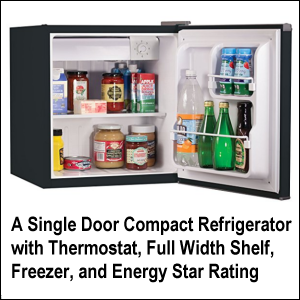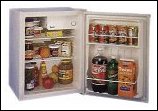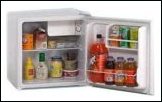Compact refrigerators, also known as mini refrigerators, are active (as opposed to passive) cooling devices designed to keep food and beverages cold.
 What factors should you as a professional driver take into account when considering buying and installing one in your truck?
What factors should you as a professional driver take into account when considering buying and installing one in your truck?
Since we have used these appliances in our truck, you may learn from our experience.
We’ll also share some buying tips and installation ideas.
(We cover other cold food storage options on our thermoelectric cooler and ice chests pages.)
Our Experience
After the numerous problems we had with thermoelectric coolers (which cool the contents only to a certain number of degrees below the surrounding outside ambient temperature) we decided to try using a cooling device that could be set to a constant temperature.
We bought and used a string of small refrigerators in our truck.
Each unit came with its own warranty which we had to use whenever the units broke down.
It must be noted that the appliances we bought were not designed for use in a moving vehicle.
It is possible that the problems we had with our compact refrigerators were due to the jarring motions inside our working 18-wheel truck.
To us, it didn’t matter which parts broke or stopped working; when the fridge stopped, there was no way to keep the contents cold.
Perhaps we would have had better success if we had purchased a more expensive appliance designed to withstand motion, such as one advertised as being specifically for a truck, boat or RV.
Installation
The first time Mike drove for one trucking company, he removed a short cabinet from his truck and lashed a compact refrigerator to the floor in its place, using rubber tie downs anchored under the washers and bolts.
On top of the fridge, he tied down a microwave oven. Other drivers may prefer to bolt their units to the floor differently.
(Please note that just because you bolt the appliance to the floor does not mean that the workings inside the unit are secure.)
Size
Most professional drivers are looking for an easy way to keep food cold.
They don’t need a lot of refrigeration space.
For them, a compact or mini refrigerator will work fine.
All refrigerators sold in the United States are measured in cubic feet.
Among the smaller sizes we have found readily available are
- 1.7 cubic feet,
- 2-2/3 cubic feet,
- 3.1 cubic feet,
- 4.0 cubic feet, and
- 4.6 cubic feet.
Besides considering the size of the cooling space you want inside the fridge, you will want to consider the amount of space you have to install the unit in your truck.
The taller the unit, the more opportunity it will have to rock back and forth while you’re traveling down the road.
The rougher the roads you travel, the more opportunity there will be for the workings to be damaged.
Weight
If you are in the habit of hauling heavy loads, the weight of a refrigerator may be of concern to you.
Generally speaking, the larger the appliance, the more it will weigh.
Consider the weight not only in your truck but when you are lifting it into your truck. (Get help with lifting it if you need it.)
Cooling and Freezing
 The compact refrigerators we bought had built-in freezer compartments that were not truly separated from the refrigerated part (like the one shown).
The compact refrigerators we bought had built-in freezer compartments that were not truly separated from the refrigerated part (like the one shown).
Foods that are stored outside but close to the freezer can freeze.
If you don’t want your produce to freeze, store it farther from the freezer.
The freezers in the units we bought were pretty small.
While standard ice cube trays did not fit, our appliances came with mini ice cube trays.
Unfortunately, there was no way to produce enough ice in the mini trays in the course of a day to keep up with our demand for ice in our water jugs (including Mike’s Bubba Keg).
So, we ended up having to use and fill a small ice chest. (Also, after running through what seemed like hundreds of bags of ice purchased at truck stops, we ended up buying and using a portable ice maker to generate enough ice to keep up with our demand.)
After realizing that we would not use the freezer to make ice, we took a chance on using it to store frozen foods.
Since the freezer unit did not extend to the rear refrigerator wall, there was always the possibility that the part of the packages hanging out of the back of the freezer would start to thaw.
There are now small refrigerators that have a separate freezer compartment.
We have no experience in using these, but speculate that were they road-worthy, they would work very well for us.
Storage Room
 Some drivers like specific foods and drinks that require specific storage arrangements.
Some drivers like specific foods and drinks that require specific storage arrangements.
For example, if you like to drink soda pop or soft drinks, you may want to have a compact refrigerator with a door that will hold two-liter drinks or cans.
Notice in the photo here one two-litter drink in the door. But only one will fit because of the configuration.
If you like drinking milk, where will you put it in your fridge?
Will you have to buy a smaller container than you’re used to buying?
Will it fit in the door?
Will you have to remove a shelf to make it fit in the main compartment?
Will it fit upright, around the freezer?
Bear in mind your own preferences when you shop.
A shorter refrigerator may not necessarily be ruled out for those who enjoy drinks from taller containers if the door has been designed with a cutaway to accommodate them.
Energy Usage
By virtue of their setting to cool continuously, compact refrigerators need constant access to an energy source.
We used an inverter that was connected directly to the truck’s batteries to power ours.
However, the battery power will last for only so long when the engine is turned off.
Owner operators with custom cabs may have their fridges powered differently.
We envision that drivers who have auxiliary power units (APUs) in their trucks have different set-ups, too.
Make sure that you have enough energy to run the unit you’re considering buying.
In researching the right unit for you, you may discover propane-powered appliances.
Please be aware that there are risks involved in using any form of bottled gas to fuel an appliance in your truck.
Our Conclusion
Based on their continual energy draw from the batteries and tendency to break, we abandoned the use of compact refrigerators in our trucks.
In the final months during which Mike drove regionally for one trucking company, he used an ice chest exclusively for keeping his cold food cold in his truck.
Update:
One of the trucking companies for which Mike drove regionally had a very small refrigerator built into the cabinet behind the driver’s seat.
Every time that he parked the truck to come home — and left the refrigerator going over the weekend — upon his return to the truck, he did not have enough power to crank the truck.
After several times of this happening, he began to turn the refrigerator off before coming home.
He was still experiencing problems cranking the truck after a weekend off.
Eventually, the batteries needed to be replaced at a cost of about $400.
![]() Money saving tip: Cost alone should not be the determining factor in your choice of any appliance.
Money saving tip: Cost alone should not be the determining factor in your choice of any appliance.
A more expensive unit can actually end up saving you money in the long run if it is built better and lasts longer.
Some units are advertised as being specifically for truck, RV or marine use.
In the descriptions we’ve seen of these “specialty” compact refrigerators, we could not personally detect a better grade of construction.
You will want to research this yourself.
Also, according to the EnergyStar.gov website,
ENERGY STAR qualified refrigerators:
* A new ENERGY STAR qualified refrigerator uses less energy than a 75-watt light bulb run continuously
* Have better insulation to keep refrigerated air from escaping
* Use efficient compressors
* Have more precise temperature and defrost mechanisms to regulate temperature more effectively
So, look for an ENERGY STAR qualified unit if you can find one among the size you’re looking to buy.
Should you be in the market to research mini fridges for your truck, feel free to use our Compact Refrigerators Comparison Table, which is available through our Free Downloads page.
Return from On Using Compact Refrigerators in an 18-Wheel Tractor Trailer to our Meal Preparation page or our Truck Drivers Money Saving Tips home page.










